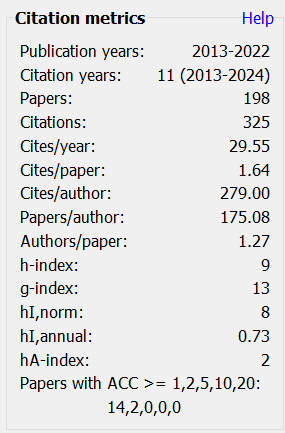Colonialism, Power and Resistance in Zadie Smith’s White Teeth
DOI:
https://doi.org/10.5958/2347-6869.2018.00003.1Keywords:
Colonialism, Zadie Smith, White Teeth, Biopolitics, race, identity, power, eugenicsAbstract
This essay attempts to analyze the colonial histories depicted in Zadie Smith's White Teeth by considering them alongside Michel Foucault's lectures on biopolitics. It also aims to contextualize some of the historical threads in the text in order to highlight some of the ways that power and resistance are performed in the fictional narrative. This will uncover important themes in White Teeth that help to identify how apparatuses of power and resistance function in the narrative, linking colonial history with contemporary multiculturalism.
DOI: 10.5958/2347-6869.2018.00003.1
Downloads
Metrics
References
Bearce, D. H., McDonald, P. J., & Rowe, D. M. (2002). Binding Prometheus: How the 19th Century Expansion of Trade Impeded Britain's Ability to Raise an Army. International Studies Quarterly, 46(4), 551-578.
Braun, M. (2013). The mouseness of the mouse: The competing discourses of genetics and history in White Teeth. The Journal of Commonwealth Literature, 48(2), 221-236.
Dalleo, R. (2008). Colonization in reverse: White teeth as Caribbean novel. In T. L. Walters (Ed.) Zadie Smith: Critical Essay, New York, NY: Peter Lang.
Fanon, F. (1997). On National Culture. In B.J. Gilbert-Moore, G. Stanton, & W. Maley (Eds.) Postcolonial Criticism (pp. 91-111). London, England: Longman.
Foucault, M. (2008). In M. Senellart, F. Ewald, & A. Fontana (Eds.) The birth of biopolitics: Lectures at the Collège de France, 1978-79. Basingstoke, England: Palgrave Macmillan.
Foucault, M., & Ewald, F. (2003) In M. Bertani, A. I. Davidson, & A. Fontana (Eds.) Society Must Be Defended: Lectures at the Colle?ge De France,1975-76 (D. Macey, Trans.). New York, NY: Picador.
Gilroy, P. (2005). Postcolonial Melancholia. New York, NY: Columbia University Press.
Hall, C. (2014). Gendering Property, Racing Capital. History Workshop Journal, 78 (1), 22-38.
Hart, B. W. (2012). Watching the 'Eugenic Experiment' Unfold: The Mixed Views of British Eugenicist Towards Nazi Germany in the Early 1930s. Journal of the History of Biology, 45(1).
Ittmann, K. (2003). Demography as Policy Science in the British Empire, 1918-1969. Journal of Policy History, 15 (4), 417-448.
Kenny, M. G. (2004). Racial Science in Social Context John R. Baker on Eugenics, Race, and the Public Role of the Scientist. Isis, 95(3), 394-419.
MacKenzie, D. (1976). Eugenics in Britain. Social Studies of Science, 6, (3/4), 499-532.
McMann, M. (2012). British Black Box: A Return to Race and Science in Zadie Smith’s White Teeth. MFS Modern Fiction Studies, 58 (3), 616-636.
Pickett, B. L. (1996). Foucault and the Politics of Resistance. Polity, 28(4), 445-466.
Reardon, J. (2004). Decoding Race and Human Difference in a Genomic Age. differences: A Journal of Feminist Cultural Studies, 15(3), 38-65.
Ryden, D. (2001). Does Decline Make Sense? The West Indian Economy and the Abolition of the Slave Trade. Journal of Inter-disciplinary History, 31(3), 347-374.
Singerman, D. R. (2015). Inventing Purity in the Atlantic Sugar World, 1860-1930. Enterprise & Society, 16(4), 780-791.
Smith, Z. (2001). White Teeth. London, England: Penguin.
Stephen, D. M. (2009). 'The White Man's Grave': British West Africa and the British Empire Exhibition of 1924-1925. Journal of British Studies, 48(1), 102-128.
Wahab, A. (2007). Mapping West Indian Orientalism: Race, Gender and Representations of Indentured Coolies in the Nineteenth-Century British West Indies. Journal of Asian American Studies, 10 (3), 283-311.

Downloads
Published
How to Cite
Issue
Section
License
Copyright (c) 2018 Ciyiltepe Tan

This work is licensed under a Creative Commons Attribution-NonCommercial 4.0 International License.
Revised Copyright/CC license that applies to all the articles published after 05-02-2017
Attribution-NonCommercial 4.0 International (CC BY-NC 4.0)

Copyright/CC license that applies to all the articles published before 05-02-2017
Attribution-Non Commercial-No Derivatives 4.0 International (CC BY-NC-ND 4.0)

Author(s) will retain all the right except commercial and re-publishing rights. In the case of re-publishing, they will have to obtain written permission from the journal. Additional licensing agreements (Creative Commons licenses) grants rights to readers to copy, distribute, display and perform the work as long as you give the original author(s) credit, they can not use the works for commercial purposes and are not allowed to alter, transform, or build upon the work. For any reuse or distribution, readers and users must make clear to others the license terms of this work. Any of these conditions can be waived if you get permission from the copyright holders. Nothing in this license impairs or restricts the authors’ rights. To view a copy of this license, visit http://creativecommons.org/licenses/by-nc-nd/4.0/ or send a letter to Creative Commons, 171 Second Street, Suite 300, San Francisco, California, 94105, USA.
Research Papers published in SOCRATES are licensed under an Attribution-NonCommercial-NoDerivatives 4.0 International (CC BY-NC-ND 4.0)
















